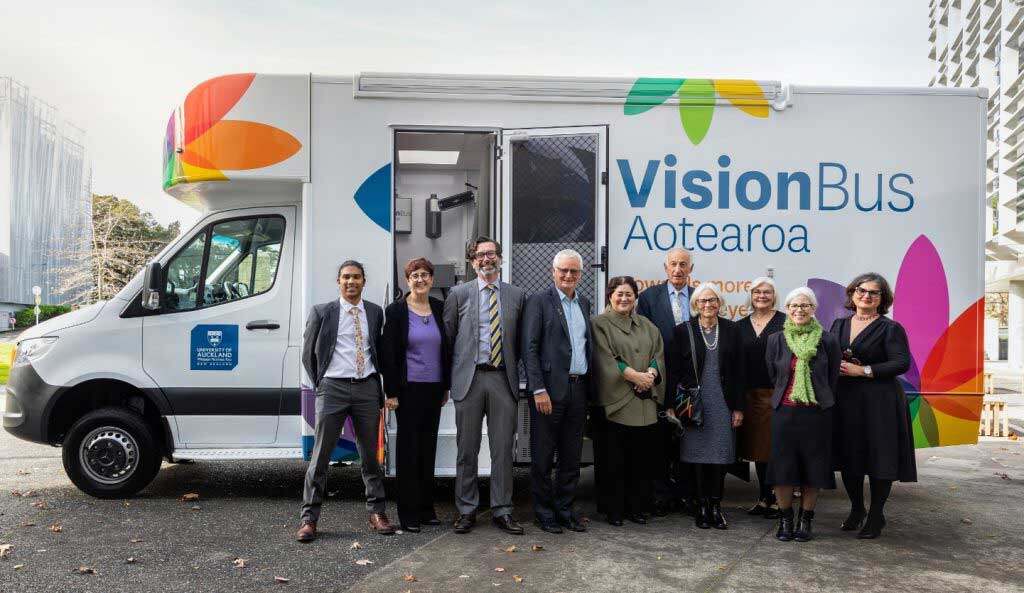The Vision Bus Aotearoa was launched in June and is already making a difference.


In its first ten weeks, the Vision Bus Aotearoa had visited seven primary schools as well as the Māngere Refugee Centre, testing people and fitting glasses for children who otherwise wouldn’t have had them.
Run through the University’s School of Optometry and Vision Science (SOVS) and funded entirely by philanthropy, the bus is driven by Veeran Morar, a professional teaching fellow in Optometry and Vision Science. He says he is motivated by seeing the look on children’s faces when they put on their first pair of glasses and see the world anew. It reminds him of his own experience.
Veeran loved playing hockey as a child but, at around 12, realised he couldn’t see the ball at the end of the field. “Mum took me to the optometrist. I put on my first pair of glasses and I was blown away. I could see the leaves on the trees. I knew at the time it was going to change my life and it did.”
Veeran went on to play hockey for New Zealand.
Vision Bus Aotearoa was officially launched at the Faculty of Medical and Health Sciences in June. Professor Steven Dakin, former head of the SOVS, had been working on the project for five years.
“When we look at schoolchildren, we know that one in ten needs glasses but doesn’t have them,” he says.“If they don’t have good visual correction, they can’t see whiteboards, which impacts them educationally. More worryingly, we see potentially blinding conditions, such as keratoconus, regularly going undiagnosed in children, with Māori and Pacific disproportionately affected.”
Barriers include cost, distance from services and knowledge of optometry services. Of those referred to the Vision Bus, two-thirds are assessed as needing glasses.
“WE EXPECT TO SEE A BIG IMPACT IN ABOUT A YEAR. CHILDREN WILL BE ABLE TO ENJOY READING.”
-Alta Van Zyl, Fairburn School, Otāhuhu
Special education needs coordinator at Fairburn School, Otāhuhu, Alta Van Zyl, says around 30 pupils who have received glasses certainly would not have otherwise.
“We expect to see a big impact in about a year. Children will be able to access texts and enjoy reading.”
She says the children have been very positive about the Vision Bus.
“One reason is they are allowed to choose their frames. It has had a positive impact on our school and our community. The kids are excited and it’s building awareness about optometry.”
Prior to driving the Vision Bus, Veeran was working in the Australian Outback as a flying optometrist.
“I fell in love with it – doing something remote where you provide a service people wouldn’t otherwise have access to.”
In another bid for equity, a team from the SOVS delivered a report to Parliament on 27 July on the state of eye health services in Aotearoa New Zealand. The researchers found the country is doing well when it comes to quality and training, but poorly for equitable access.
“We are calling for the government to develop an eye health strategy that will enable funding to improve access,” says one of the authors, Dr Renata Watene.
The Vision Bus is funded by Rae and Peter Fehl, a former University staff member, who heard Steven talking about his dream for the unit on RNZ. The $1.8m donation by the Fehl Family Trust funds the vehicle and its service for the first five years.
Steven says there was also a need to offer children glasses and contact lenses, which is where further donors have ‘closed the loop’. These include Helen Blake and daughter Barbara, through the George Cox Community Spectacle Fund (George was Helen’s father) and Essilor, an international optics company, who are subsidising the cost of spectacles.
The hope is that the service model being developed around the bus – delivering eye-health services in partnership with local communities – will be widely adopted and government funded in the future.
Story by Jodi Yeats






































